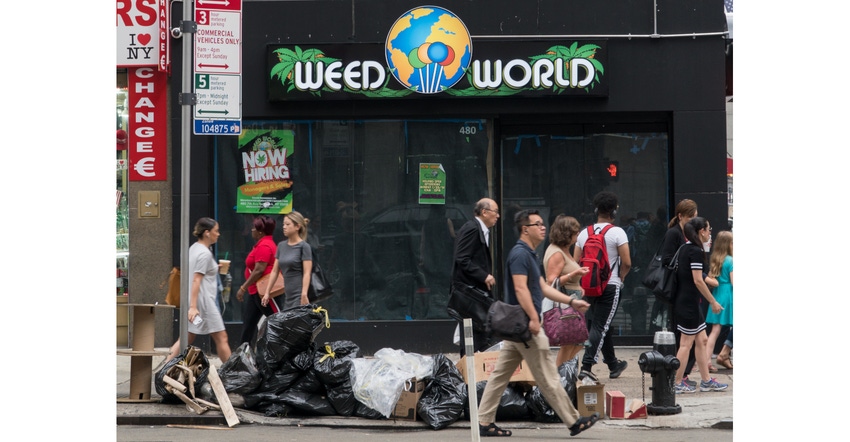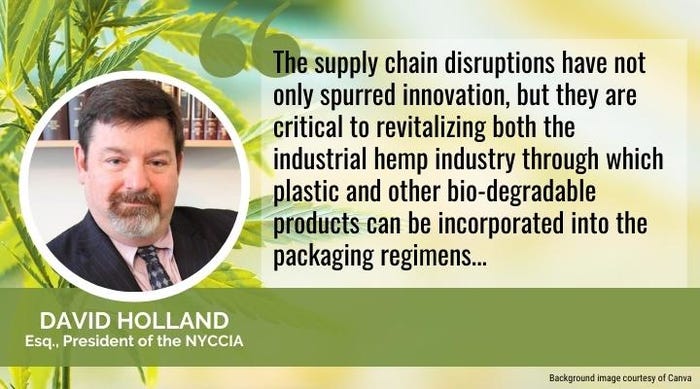Experts Explore Cannabis Packaging Regulations in the Northeast Region
The upcoming in-person CannPack East event includes conference sessions that will share the best ways for cannabis packagers to stay ahead of regulatory trends.

Cannabis is one of the nation’s fastest growing industries of all time. In fact, by 2030, annual sales are predicted to surpass $100 billion. This burgeoning sector attracts adult consumers of all backgrounds — and that poses challenges for brand owners and manufacturers as they work to cater their packaging styles to various audiences while navigating the ever-changing regulatory landscape across each legalized state.
Not too long ago, cannabis was packaged in plastic baggies as distribution skirted laws. Now with legalization of recreational and medicinal cannabis continuing to spread with more than 70% of states legalizing it for medical and/or adult use, packaging of cannabis flower, tinctures, oils, pens, and edibles is one of the most complicated state regulated industries, alongside alcohol sales and the healthcare field.
While the industry has made incredible strides over the past few years, there remains an excess of challenges and roadblocks when it comes to packaging product. Manufacturers and packagers need to navigate the many laws that ensure user safety and provide peace of mind for consumers. They must also be hyper-aware of regulations that vary state-by-state, as well as on a federal level that does not permit cannabis sales or distribution, and even globally. Layer in consumer trends like sustainability and the critical need to ensure child-proof packaging, and packagers may feel as though they are fighting on multiple fronts (they are).
A renowned association providing guidance for manufacturers as they produce sustainable, safe, and professional packaging solutions is the New York City Cannabis Industry Association (NYCCIA), a prominent partner at the upcoming CannPack East conference and exhibition. CannPack East, one of six co-located event brands that make up IM Engineering East, is strategically designed to connect experts and facilitate peer-to-peer conversation that will help today’s leaders gain a competitive edge in the booming cannabis market and gain deep insights into the complex technical challenges around cannabis packaging.
With CannPack slated to be held December 7-9 at the Jacob Javits Convention Center in New York City, I had the distinct pleasure of speaking with experts scheduled to speak at the event:
• Michelle Fields, Esq., Strategic Consultant and Global Advisor at The Mary Jane Consulting Group,
• Sheri Tarr, Esq., Chief Advisor and Regulatory Strategist at ’68 Partners consulting,
• Andrew Schriever, Esq., Co-founder of the NYCCIA and Partner and Chair of the Cannabis Law Practice at Cuddy & Feder LLP, and
• David Holland, Esq., President of the NYCCIA and Principal of The Law Offices of David Clifford Holland, P.C.
We discussed the most pressing practical and legal issues surrounding the cannabis packaging industry and what attendees can look forward to learning about at their upcoming session titled “Cannabis Packaging Regulatory Round-Up - Northeast US.”
Michelle, Sheri, Andrew, and Dave, it’s a pleasure. Could you speak to the challenges posed to cannabis and hemp packaging that are the result of different state regulations?
Fields: The challenges posed to cannabis and hemp businesses are numerous because of the various regulations and standards required in legalized states. The lack of uniformity, sustainable practices, and a green supply chain has increased business costs. For example, California now requires long- or short-term Prop 65 warning labels on all THC products — topicals, edibles, and vapor — and/or visibly displayed on store shelves.
Conversely, businesses must follow strict guidelines, with many states relying on the FDA [Food and Drug Administration] and guidance from the FTC [Federal Trade Commission], including New York. The strict guidelines address misbranding, misleading (truth in advertising), and adulteration, child-proof and non-attractive nuisance, including Good Manufacturing Practice (GMP) and Certification and Certificates of Analysis (COAs).
The biggest challenge for the industry is waste, especially when it comes to the required RFID (radio frequency identification) inventory tags and plastic.
Tarr: The package (and label) is often the first interaction a consumer has with a brand. It is also the first place FDA looks before taking adverse action against a company.
For cannabis marketers and operators, getting packaging right is critical to the sustainability of any brand, and yet it is one of the more difficult aspects of bringing cannabis products to market. Unlike with most consumer-packaged goods, with cannabis products, numerous federal, state, and local agencies and regulatory authorities — FDA, FTC, DEA [Drug Enforcement Administration], and state departments of agriculture, health, and pharmacy, to name only a few — have varying levels of oversight authority. And each imposes its own rules, regulations, and guidelines for packaging of cannabis products.
What’s more, every product form, be it tincture, topical, beverage, or pre-roll, has its own unique considerations. For responsible cannabis marketers and packaging players, navigating this complex matrix of local, state, and federal regulations. And translating them into real-world packaging solutions that strike the right balance between creativity and regulatory compliance, poses a significant challenge.
Schriever: A legal conundrum exists because there is no uniform labeling or packaging standard that crosses all state borders to ensure consumer safety. The problem becomes whether a product that satisfies its home state’s product safety and packaging standards can be prohibited in another state that may have more exacting testing, safety, labeling, and packaging standards. Such prohibitions from one state to the next implicates the US Constitution’s “Dormant Commerce Clause” and can invalidate state laws that inhibit interstate commerce even though the sale and distribution of cannabis is illegal under federal law.
Instead of waiting for the federal government to act, which would likely first require the step of declassifying cannabis as a Schedule I narcotic, states can develop a uniform set of standards among themselves, with the help of industry associations like ours. This approach can eliminate the Constitutional issues and remove barriers to free interstate commerce once the federal government eventually does decriminalize cannabis.
What is a significant trend or industry disruption that you are seeing impacting the cannabis packaging sector?
Fields: The most significant are disruptions in the global supply chain, causing inventory shortages due to COVID-19 and the required quality assurance protocols. These disruptions have impacted vertically and horizontally integrated cannabis companies (plant and non-plant touching) that rely on materials (single use) and parts from overseas, especially China and Indonesia, including high freights costs.
Though the impact has been great, this has forced cannabis businesses to focus and use local sourcing. Thus, the localized supply chain is taking a competitive lead in the domestic cannabis industry.
Tarr: On the one hand, the complex regulatory landscape discussed earlier poses a real challenge to the cannabis packaging sector. On the other hand, these challenges have spawned innovative technologies that, when used in conjunction with the support of experienced compliance professionals, actually help MSOs [multi-state operators], brands, and packagers track and comply with local, state, and federal regulations.
Holland: The supply chain disruptions have not only spurred innovation, but they are critical to revitalizing both the industrial hemp industry through which plastic and other bio-degradable products can be incorporated into the packaging regimens, as well as promoting farming and other alternative resources to build new economies derived from the burgeoning cannabis industry.

I understand you all are presenting a panel discussion about these types of issues at CannPack East alongside your peers. Could you share insights attendees can look forward to learning in your session?
Fields: The most important insight, I believe, is how we can use regulations to create bridges and not walls. How can the domestic cannabis and hemp industries bring about universal uniformity in labeling, packaging, and sustainable practices, thus creating a green supply chain to reduce costs?
Tarr: CannaPack East attendees can look forward to getting a better understanding about the process of commercializing FDA regulated products, and the significant role that compliant packaging and labeling plays in the building of a sustainable brand.
Attendees will also gain clarity about the complex and confusing regulatory landscape, along with insights about how to navigate the choppy regulatory waters and commercialize successful brands — without cutting corners.
Schriever: Attendees and industry participants will get some insights beyond the practical implications of packaging and labeling that will guide them in how to envision product promotion and development on a national scale. As competition increases in the space, there is a corresponding need to understand the different ways in which a small operator can employ legal strategies, develop brand loyalty, and expand in the market by anticipating the best ways to stay ahead of the regulatory trends.
What excites you most about engaging with your community in-person this December?
Fields: For me, this in-person event is an opportunity to engage with my peers in seeking a consensus on how industry leaders and experts can work with the community to build a less regulatory restrictive and cost-prohibitive marketplace. The in-person engagement and collaboration will allow the industry to advocate for sustainable practices and a decentralized marketplace. I’m looking forward to this expo that will bring together thought-leaders and the community, which is infrequent.
Tarr: We are all in this exciting, yet highly regulated and risky, space together. These events engender important exchanges of ideas and dialogue amongst members of the cannabis community, which in the end helps to build a responsible, robust, and accessible marketplace for all participants. I am excited to learn from and interact with my colleagues, as well as other cannabis market enthusiasts from all walks of life.
Holland: The opportunity to produce a panel discussion to educate and be educated by top-notch industry players and aspiring marketplace entrants about the practical impediments to the industry and forecasting the impact of solutions we devise for our clients is truly exciting. That is the mission of the NYCCIA and what makes us one of the most important policy focused organizations and think-tanks in New York State and beyond.
Come attend this session and also explore the six-in-one event designed to connect the region’s most prominent visionaries advancing the packaging, cannabis, design, and smart manufacturing sector. Register for an Expo and Conference pass here.
About the Author(s)
You May Also Like




